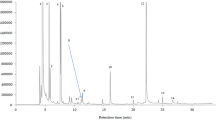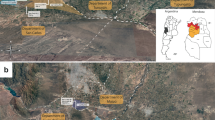Abstract
Samples of commercial and authentic [authentic samples are samples produced under microvinification conditions (see Schlesier et al. Eur Food Res Technol, 2009)] wines were collected from four countries (Hungary, Czech Republic, Romania, and South Africa) and three different vintages. They were analyzed for 63 chemical parameters in the context of the European project “Establishing of a wine data bank for analytical parameters from Third Countries”. The aim of the project was to apply multivariate classification techniques to determine the country of origin of wines based on their chemical content. Moreover, it was important to evaluate whether models built for authentic samples can be used to discriminate commercial samples. Here we report on the descriptive and exploratory data analysis and discuss the univariate statistical results. These indicate that South African wines are easily discriminated from the other countries on the basis of a single isotopic ratio such as Ethanol(D/H)1. The discrimination of the European countries and especially the separation between Hungarian and Czech wines is less straightforward.









Similar content being viewed by others
References
Koronovska M, Suhaj M (2005) Eur Food Res Technol 221:550–558
Baxter MJ, Crews HM, Dennis MJ, Goodall I, Anderson D (1999) Food Chem 378:301–310
Sun L, Danzer K, Thiel G (1997) Fresenius J Anal Chem 359:143–149
Thiel G, Geisler G, Blechschmidt I, Danzer K (2004) Anal Bioanal Chem 378:1630–1636
Martin GJ, Mazure M, Jouitteau C, Martin YL, Aguile L, Alain P (1999) Am J Enol Viticult 50:409–417
Gonzalez G, Pena-Mendez EM (2000) Eur Food Res Technol 212:100–107
Gremaud G, Quaile S, Piantini U, Pfammatter E, Corvi C (2004) Eur Food Res Technol 219:97–104
Marini F, Bucci R, Magrì AL, Magrì AD (2006) Chemom Intell Lab Syst 84:164–171
Schlesier K, Fauhl-Hassek C, Forina M, Cotea V, Kocsi E, Schoula R, Van Jaarsveld F, Wittkowski R (2009) Characterization and determination of the geographical origin of wines, part I: overview. Eur Food Res Technol (submitted)
Massart DL, Vandeginste BGM, Buydens LMC, De Jong S, Lewi PJ, Smeyers-Verbeke J (1997) Handbook of Chemometrics and Qualimetrics: Part A. Elsevier, Amsterdam
Vandev V (2005) PLISKA Stud Math Bulg 17:323–335
Harper AM, Duewer DL, Kowalski BR, Fashing JL (1977) ARTHUR and experimental data analysis. In: Kowalski BR (ed) Chemometrics: theory and applications, ACS Symposium Series 52. Am Chem Soc Publ., p 43
Ingraham NL, Caldwell EAJ (1999) Geophys Res Atmos 104(2):2185–2194
Martin GJ, Martin ML (2003) Phytochem Rev 2:179–190
Rossman A, Reneiro F, Moussa I, Schmidt H-L, Versini G, Merle MH (1999) Z Lebensm Unters Forsch 208:400–407
Barbaste M, Medina B, Sarabia L, Ortiz MC, Pérez-Trujillo JP (2002) Anal Chim Acta 472:161–174
Sperková J, Suchanek M (2004) Food Chem 4:659–663
Acknowledgments
The authors acknowledge the contributions of the European Commission for the financial support of this work, which was carried out in the framework of the specific research and technological development program “Competitive and Sustainable Growth” (Contract G6RD-CT-2001-00676). The authors are solely responsible for the content of this research article and the European Community is not responsible for any use that might be made of the data appearing therein. This article is dedicated to Professor D.L. Massart, who initially took the lead of the chemometrics/statistics group in the project. Unfortunately he passed away during the project on 26 December 2005. Finally, the authors would like to thank all the partners of the European Wine DB project and especially the ones who collected the different wine samples, performed the micro-vinification of the authentic samples and did the analytical measurements of all the parameters necessary to carry out this study.
Author information
Authors and Affiliations
Corresponding author
Additional information
Project participants
R. Wittkowksi, BfR, Germany; C. Fauhl-Hassek, BfR, Germany; K. Schlesier, BfR, Germany; P. Brereton, CSL, United Kingdom; M.Baxter, CSL, United Kingdom; E. Jamin, Eurofins, France; X. Capron, VUB, Belgium; J. Smeyers-Verbeke, VUB, Belgium; C. Guillou, JRC, Italy; M. Forina, UGOA, Italy; U. Römisch, TU Berlin, Germany; V. Cotea, UIASI.VPWT.LO, Romania; E. Kocsi, NIWQ, Hungary; R. Schoula, CTL, Czech Republic; F. van Jaarsveld, ARC Infruitec-Nietvoorbij, South Africa; Jan Booysen, Winetech, South Africa.
Rights and permissions
About this article
Cite this article
Smeyers-Verbeke, J., Jäger, H., Lanteri, S. et al. Characterization and determination of the geographical origin of wines. Part II: descriptive and inductive univariate statistics. Eur Food Res Technol 230, 15–29 (2009). https://doi.org/10.1007/s00217-009-1142-9
Received:
Revised:
Accepted:
Published:
Issue Date:
DOI: https://doi.org/10.1007/s00217-009-1142-9




